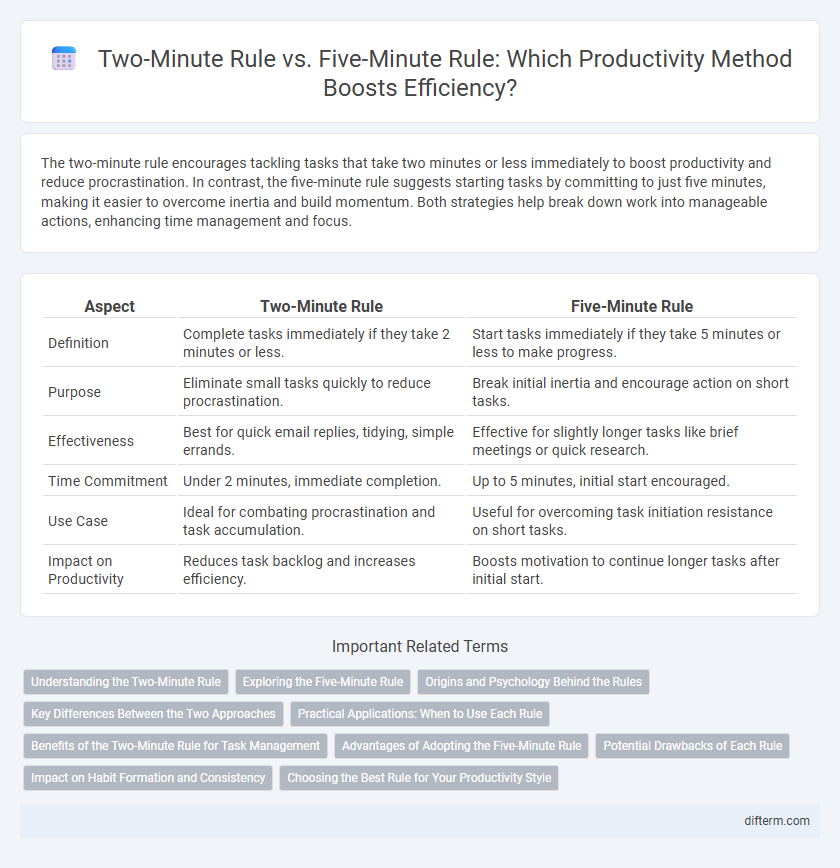The two-minute rule encourages tackling tasks that take two minutes or less immediately to boost productivity and reduce procrastination. In contrast, the five-minute rule suggests starting tasks by committing to just five minutes, making it easier to overcome inertia and build momentum. Both strategies help break down work into manageable actions, enhancing time management and focus.
Table of Comparison
| Aspect | Two-Minute Rule | Five-Minute Rule |
|---|---|---|
| Definition | Complete tasks immediately if they take 2 minutes or less. | Start tasks immediately if they take 5 minutes or less to make progress. |
| Purpose | Eliminate small tasks quickly to reduce procrastination. | Break initial inertia and encourage action on short tasks. |
| Effectiveness | Best for quick email replies, tidying, simple errands. | Effective for slightly longer tasks like brief meetings or quick research. |
| Time Commitment | Under 2 minutes, immediate completion. | Up to 5 minutes, initial start encouraged. |
| Use Case | Ideal for combating procrastination and task accumulation. | Useful for overcoming task initiation resistance on short tasks. |
| Impact on Productivity | Reduces task backlog and increases efficiency. | Boosts motivation to continue longer tasks after initial start. |
Understanding the Two-Minute Rule
The Two-Minute Rule, popularized by productivity expert David Allen, suggests immediately completing any task that takes two minutes or less to prevent task accumulation and reduce procrastination. This technique enhances focus and momentum by breaking complex projects into manageable actions, leveraging quick wins to maintain productivity flow. Understanding the distinction, the Five-Minute Rule offers a slightly longer time frame but may risk task buildup, making the Two-Minute Rule more effective for maintaining consistent daily task management.
Exploring the Five-Minute Rule
The Five-Minute Rule enhances productivity by encouraging immediate action on tasks that take five minutes or less, reducing procrastination and increasing workflow efficiency. This approach extends the principle of the Two-Minute Rule, accommodating slightly longer tasks that still benefit from quick completion to prevent buildup. Implementing the Five-Minute Rule helps maintain momentum throughout the day by swiftly addressing small but important actions before they escalate into larger, more time-consuming problems.
Origins and Psychology Behind the Rules
The Two-minute rule, popularized by productivity expert David Allen in his Getting Things Done methodology, encourages completing tasks that take less than two minutes immediately to reduce procrastination and build momentum. The Five-minute rule, based on behavioral psychology principles, suggests committing to an activity for just five minutes to overcome inertia and increase the likelihood of continuation. Both rules leverage cognitive biases such as the Zeigarnik effect and habit formation to enhance focus and task initiation.
Key Differences Between the Two Approaches
The two-minute rule, popularized by productivity expert David Allen, suggests immediately completing any task that takes two minutes or less, whereas the five-minute rule encourages starting tasks that require up to five minutes to build momentum. The key difference lies in task initiation versus task completion time frames, with the two-minute rule emphasizing quick finishing and the five-minute rule stressing overcoming procrastination by simply beginning tasks. This distinction impacts efficiency by reducing task backlog through rapid completions in the two-minute rule compared to fostering consistent progress in longer tasks using the five-minute rule.
Practical Applications: When to Use Each Rule
The Two-minute rule is ideal for tackling small tasks that can be completed immediately, such as responding to quick emails or tidying up a workspace, enhancing overall efficiency by preventing task buildup. The Five-minute rule suits slightly larger tasks that require brief, focused effort, like drafting a quick outline or preparing a meeting agenda, helping to initiate momentum without overwhelming the schedule. Choosing between these rules depends on task complexity and available time, optimizing productivity through effective time management strategies.
Benefits of the Two-Minute Rule for Task Management
The Two-Minute Rule enhances task management by encouraging immediate action on tasks that take less than two minutes, reducing procrastination and preventing small tasks from accumulating. This approach improves focus and efficiency by minimizing decision fatigue and keeping the to-do list manageable. By quickly completing minor tasks, users maintain momentum and free mental space for more complex projects.
Advantages of Adopting the Five-Minute Rule
The five-minute rule enhances productivity by allowing slightly longer tasks to be completed immediately, reducing procrastination and task accumulation. This approach helps maintain momentum without overwhelming focus, improving overall task management efficiency. Adopting the five-minute rule also supports better prioritization by addressing important but brief activities promptly, boosting workflow continuity.
Potential Drawbacks of Each Rule
The two-minute rule may lead to frequent task-switching, reducing overall focus and increasing cognitive load. The five-minute rule can encourage procrastination by justifying short delays, potentially accumulating unfinished tasks. Both rules risk creating a false sense of productivity without addressing deeper time management skills.
Impact on Habit Formation and Consistency
The two-minute rule accelerates habit formation by encouraging immediate, manageable actions that reduce procrastination and build consistency through quick wins. The five-minute rule allows slightly longer task commitment, which can deepen focus and enhance routine stability but may pose a higher initial barrier, impacting consistency for those prone to delay. Both methods improve productivity by leveraging small time investments to establish and maintain positive habits, with the two-minute rule favoring rapid engagement and the five-minute rule supporting more sustained effort.
Choosing the Best Rule for Your Productivity Style
The Two-minute rule emphasizes completing tasks that take two minutes or less immediately, ideal for those who thrive on quick wins and rapid momentum. The Five-minute rule suits individuals who prefer slightly longer, focused bursts to tackle small tasks without frequent interruptions in workflow. Selecting the best rule depends on your productivity style: fast-paced multitaskers benefit from the Two-minute rule, while those requiring deeper concentration achieve more through the Five-minute rule.
Two-minute rule vs Five-minute rule Infographic

 difterm.com
difterm.com